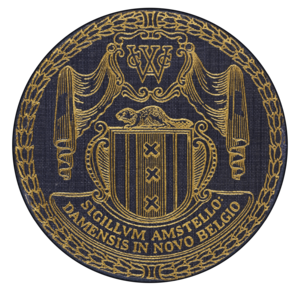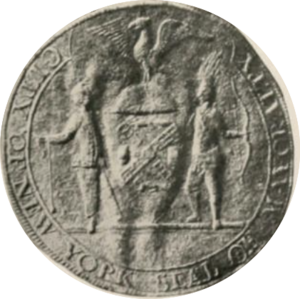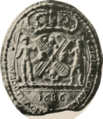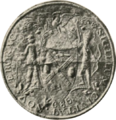Seal of New York City facts for kids
Quick facts for kids Seal of New York City |
|
|---|---|
 |
|
| Armiger | New York City |
| Adopted | 1915 (modified 1977) |
| Crest | An American eagle with wings displayed, upon a hemisphere |
| Blazon | Saltire-wise, the sails of a windmill. Between the sails, in chief a beaver, in base a beaver, and on each flank a flour barrel. |
| Supporters | Dexter (bearer's right, viewer's left), a sailor, his right arm bent, and holding in his right hand a plummet; his left arm bent, his left hand resting on the top of the shield; above his right shoulder, a cross-staff. Sinister (bearer's left, viewer's right), an Indian of Manhattan, his right arm bent, his right hand resting on top of the shield, his left hand holding the upper end of a bow, the lower end of which rests on the ground. |
| Motto | Sigillum Civitatis Novi Eboraci (Latin for "Seal of the City of New York") |
| Other elements | Shield and supporters rest upon a horizontal laurel branch. Beneath the horizontal laurel branch the date 1625. A laurel wreath encircles the seal. |
| Earlier version(s) | Many, dating to 1654 |
| Use | On documents from the city, as a symbol identifying officers of the city, adorning city property and the city flag |
The seal of New York City is the city's official symbol. It is used on important papers and publications from the city government. You can also see it carved into city buildings and on the city's flag. It helps everyone know that something is officially from New York City.
New York City has had a seal since 1654. Back then, it was a Dutch settlement called New Amsterdam. The seal has changed many times over the years. These changes happened as the city went from Dutch to British, and then to American control. Sometimes, there were even disagreements between the mayor and the city's elected council. The seal we see today was first designed in 1915 and was last updated in 1977.
The city clerk of New York City is in charge of keeping the city seal safe.
What the New York City Seal Looks Like
Main Parts of the Seal
The New York City seal has several important parts, much like a coat of arms. These parts include a shield, figures that support the shield, and a crest on top.
- The Shield: This is the main part in the middle. It shows the sails of a windmill. Between the sails, you can see two beavers and two barrels of flour.
- The Supporters: These are the two figures standing on either side of the shield. On the right side (from the shield's point of view), there is a sailor. He holds a tool called a plummet and has a cross-staff over his shoulder. On the left side, there is a Lenape Native American from Manhattan. He holds a bow.
- The Crest: This is at the very top of the seal. It shows an American eagle with its wings spread out, standing on half of a globe.
- The Date: Below the shield, you will see the year 1625. This date marks when New Amsterdam was founded.
- The Motto: A ribbon below the date has the Latin words "Sigillum Civitatis Novi Eboraci." This means "Seal of the City of New York."
- The Wreath: The entire seal is surrounded by a laurel wreath.
What the Symbols Mean
The design of the current New York City seal comes from a seal first used in 1686. Each part of the seal tells a story about the city's past.
The two figures supporting the shield represent friendship. They show the connection between Native Americans and the early European settlers. The sailor holds tools used for navigation, like a plummet and a cross-staff. The Native American holds a bow.
On the shield, the four windmill sails remind us of the city's Dutch beginnings as New Amsterdam. The beavers and flour barrels show the city's first important trade goods. For example, the flour barrels and windmills represent the great wealth New York City made from a law in 1674. This law gave the city the only right to mill and export flour. The shield and its supporters rest on a horizontal laurel branch.
The American eagle at the top was added in 1784. This was after the American Revolution. The eagle came from the seal of New York State. Before the eagle, there was a crown, which showed the power of the British king. The eagle stands on a hemisphere, which looks like half of a globe.
The date 1625 below the shield is when New Amsterdam became the capital of the New Netherland province. There has been some debate among historians about this date. Some believe the first European settlers arrived in 1624. New Amsterdam officially became a city in 1653. Different founding dates have been on the seal throughout history. The Latin motto "Sigillum Civitatis Novi Eboraci" means "Seal of the City of New York." Eboracum was the Latin name for York, England. New York City was named after James II, who was the Duke of York.
A laurel wreath surrounds the whole seal. This wreath is an old Greek symbol of victory.
How the Seal is Used
General Uses

The rules for New York City say that the city seal "shall be used for all necessary purposes." This means the city clerk and other city officials must use it. The seal can be:
- Printed on official papers, books, or stationery from the city.
- Carved or shown on buildings or structures owned by the city.
- Used in other official ways.
The city rules also say that the seal should appear on the city flag. It is blue and placed on the middle white stripe. When used on the flag, the Latin motto "Sigillum Civitatis Novi Eboraci" is left off.
In real life, you can see the city seal on podiums. Mayors and other city officials use these podiums when they give speeches. The city also sells items with the seal on them.
On the City Flag
Before 1915, New York City did not have an official flag. People used an unofficial flag that had a version of the city seal on a white background. In 1915, a committee that redesigned the city seal also helped create the city's official flag. The new flag featured a slightly changed version of the seal. The main difference was that the Latin motto was not included.
Rules for Using the Seal
New York City has strict rules about how the seal can be used. It cannot be changed or have anything added to its design. The only exceptions are when it is used on the city flag or for decoration on buildings. In these cases, the Latin motto can be left out. If a seal is damaged or no longer used, the city clerk must keep it.
Also, only the city clerk and other authorized city officials can use the seal. If someone uses the city seal on a vehicle that is not owned by the city, they can be fined or even jailed.
History of the Seal
The First Seal (1654)
Before 1654, the Dutch settlement of New Amsterdam used the seal of New Netherland. After New Amsterdam became its own city in 1653, it asked the Dutch West India Company for its own seal. The company chose a design that included its own symbol and a beaver. It also had a shield with a changed version of the arms of Amsterdam. Historians believe the shield had a black stripe, white crosses, and a red background. The colors at the top were likely orange, white, and blue, like the flag of the Netherlands.
The 1669 Seal
New Amsterdam became British in 1664 and was renamed New York. However, the old Dutch seal was still used until 1669. In that year, New York City and the province received new seals. But we do not know what the 1669 city seal looked like, as no descriptions or uses of it have been found.
The 1686 Seal and the "Small Seal"
In 1683, the city asked the governor for an official charter. This charter would give the city the right to create its own seal. The charter was granted in 1686. On July 24, 1686, the city adopted a new seal. This was the first seal designed and approved by the city itself. This seal had many parts that are still on the current seal. These include the shield with windmill sails, beavers, and flour barrels. It also had a colonial sailor and a Native American as supporters, a Latin motto, a founding date (1686), and a laurel wreath.
The first known use of the 1686 seal showed a ducal crown at the top. This has puzzled historians. The city's owner, James II, had become King of England in 1685. So, an imperial crown would have made more sense. Later uses of the seal show that it was changed to an imperial crown. We do not know the exact date of this change.
One interesting thing about the 1686 seal is how the Native American supporter is shown. He wears a war bonnet, which was not a type of headdress worn by the Eastern Algonquian people who lived in Manhattan.
After the 1686 seal, a slightly different "small seal" appeared on documents. No one knows how this second seal was created.
The 1735 Mayoral Seal
In 1735, a disagreement between the city council and the mayor led to a new seal. The 1686 seal and the "small seal" remained official. But a third seal was made just for the mayor. This mayoral seal was similar but circular and said "City of New York Seal of Mayoralty." A law was then passed to say which seal should be used for which purpose.
The 1784 Seals
After the American Revolutionary War ended in 1783, New York City had three official seals. One of the first things the city council did was remove the British crown from these seals. In 1784, new seals were adopted. The crest now featured an eagle on a hemisphere, taken from the seal of New York State. The city council described the new seals and their uses in newspapers. The "small seal" was identified as the seal for the Mayor's Court.
Besides removing the British crown and adding the eagle, the 1784 city seal was mostly the same. However, the Native American's bow was drawn incorrectly. Also, the cross-staff was removed from the colonial sailor. Fruit branches were added on either side of the shield.
The 1784 city seal design was officially used throughout the 1800s. During this time, the mayoral seal and the Mayor's Court seal were used less and less.
The 1915 Seal
Between 1784 and 1915, many unofficial changes were made to the city seal. These happened because of mistakes, artistic choices, or people not knowing the correct design. Sometimes, the sailor and Native American switched places. Their looks also changed. The eagle was sometimes drawn facing the wrong way. Other things, like anchors or ships, were sometimes added.
As the 250th anniversary of the city's first mayor came closer, the many different versions of the seal caused problems. So, the city created a committee to find the correct design. This committee worked with the New-York Historical Society. They studied old images and seals from the time of New Amsterdam. They used this history to create a new seal design. The city approved this design in 1915. The city also hired a famous sculptor, Paul Manship, to make a physical version of the new seal. After this, the city once again had only one seal for all government offices. The city also adopted an official flag, which featured a version of the new seal.
The 1915 seal stayed true to the 1686 design. The main difference was the crest, which used the eagle and hemisphere from the 1784 seal. Mistakes in how the Native American was shown were fixed. The cross-staff was put back for the sailor. Also, the founding date on the seal was changed from 1686 to 1664. This was the year the city's name changed to New York.
The 1977 Seal
The most recent change to the city seal happened in 1977. This was because the president of the City Council wanted to honor the city's Dutch beginnings. In 1974, he suggested changing the founding year on the city's flag from 1664 to 1625. The year 1625 was when New Amsterdam became the seat of government for New Netherland. However, historians noted that this was not the year New Amsterdam was officially founded or built. Despite objections from historians, Mayor Abraham Beame signed the bill to change the date on the city flag in 1975. A separate bill to change the city seal in the same way was approved two years later.
Since 1977, the seal has sometimes been reviewed. For example, in 2020, Bill de Blasio, who was mayor at the time, suggested a group study the seal's design. This happened after the George Floyd protests.
Gallery
-
A decorative shield and supporters in New York City Hall.















